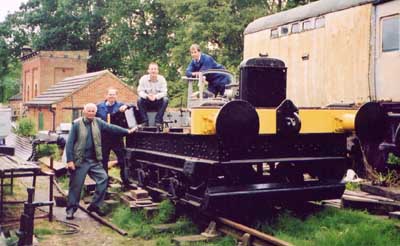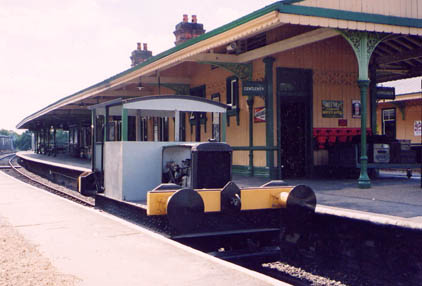
The overhaul of Howard Locomotive No.957

The restoration of the Bluebell's only non-steam locomotive (albeit a very small one) began in the early 1970s. The original intention was to repair the petrol engine and return the locomotive to Sheffield Park. When its cast iron wheels were found to be damaged the loco was lifted to see if repairs could be made. An old repair to an axle was then discovered and this effectively condemned both wheelsets.
As dismantling continued many other parts were found to be badly worn. By then the locomotive had became something of a restoration project in its own right but had to be fitted in and around higher priority work being carried out by the Alf Brown Group for various departments on the Bluebell.
 The axleboxes, clutch release mechanism, radiator and brake rigging all required rebuilding in various degrees. The locomotive frame made from hot rolled steel sections was fairly sound although some members had to be built up or straightened. One large reinforcing plate buckled by corrosion was removed for repair and then riveted back. New wheelsets were made that copied the original design except that the wheels were cast in steel with BR flange profiles and the axles were made in a stronger grade of steel.
The axleboxes, clutch release mechanism, radiator and brake rigging all required rebuilding in various degrees. The locomotive frame made from hot rolled steel sections was fairly sound although some members had to be built up or straightened. One large reinforcing plate buckled by corrosion was removed for repair and then riveted back. New wheelsets were made that copied the original design except that the wheels were cast in steel with BR flange profiles and the axles were made in a stronger grade of steel.
Left: The locomotive frame is craned out of a coal bunker at Horsted Keynes, 15 February 1997, to clear the way for embankment strengthening.
Progress accelerated in 1997 when the frame of the locomotive was craned out of a pump house coal bunker at Horsted Keynes. This had become its home since the long siding behind the signal box was extended beyond the loco's original location. The damp conditions in the bunker undid many hours of preparation on the frame.
Left: The gearbox and engine is craned into position on 29 March 1998.
Right: The machined wheelsets were returned to Horsted Keynes in August 2001 using the P/Way 'mini well wagon'.
The project made significant progress in August 2001 with the machining of the new wheelsets at Sheffield Park. The co-operation of the workshop staff is gratefully acknowledged. At time of writing, January 2004, the reassembly of the locomotive is virtually complete although the new cab sheeting has been temporarily bolted on before riveting. Repair of the engine bonnet has now commenced, the last item requiring significant work.
 The locomotive was reunited with the rails on 1 July 2002 (photo right) in the presence
of Ken Dickens (furthest left) who researched the J&F Howard business and negotiated
to rescue 957 from scrap in 1965. Jim Hay, third from the left, is closely
involved with industrial railway preservation and owns a narrow gauge
Howard locomotive and wagons. For one day most of the expertise with J&F
Howard Ltd and their locomotives is concentrated in one place!
The locomotive was reunited with the rails on 1 July 2002 (photo right) in the presence
of Ken Dickens (furthest left) who researched the J&F Howard business and negotiated
to rescue 957 from scrap in 1965. Jim Hay, third from the left, is closely
involved with industrial railway preservation and owns a narrow gauge
Howard locomotive and wagons. For one day most of the expertise with J&F
Howard Ltd and their locomotives is concentrated in one place!
With most of the locomotive now back together the bonnet is having some attention. It is probably made from sheet iron judging by its ductility. Some small areas behind reinforcing strips have corroded away and these have been repaired by welding in new pieces of sheet steel. One larger patch had to be carefully let in on the west side to repair an ugly hole made when the exhaust pipe had been redirected straight through the bonnet side to gain an 'easier' route (as seen in the photo, below, taken at Sheffield Park many years ago by Fred Redgrave). The new exhaust follows the correct path. The east side also has a patch but dates from early days. This matches a blister in the bonnet side of a narrow gauge locomotive illustrated in Howards 1926 advertising literature. Perhaps 957's bonnet was made from a pre-cut sheet for a smaller loco.
 The opportunity has been taken to carefully cut through the paint layers on
the bonnet and old cab sheets. Several layers have been identified and the
colours matched and recorded. The livery has always been green the first
being a very dark shade and later ones similar to the Light Brunswick last
applied. Its second and third coats had bright yellow lining on the cab
rear and sides and bonnet sides. The cab had lettering for the Britannia Iron & Steel Co on one side
only. It is likely
that the penultimate coat will be used as a model for its restoration.
The opportunity has been taken to carefully cut through the paint layers on
the bonnet and old cab sheets. Several layers have been identified and the
colours matched and recorded. The livery has always been green the first
being a very dark shade and later ones similar to the Light Brunswick last
applied. Its second and third coats had bright yellow lining on the cab
rear and sides and bonnet sides. The cab had lettering for the Britannia Iron & Steel Co on one side
only. It is likely
that the penultimate coat will be used as a model for its restoration.
The original data published by J&F Howard Ltd suggests that the locomotive could move safely the equivalent weight of two carriages on the gradients to be found on the Bluebell. The usefulness of 957 will only be determined by thorough testing when it is running satisfactorily.
The loco was formally unveiled in service for the 50th Anniversary Gala on 6th August 2010.The photos below from Richard Salmon and Derek Hayward show it in use, on Sunday 8th August, at the event.


"JoeS231989" has a YouTube video from the Gala weekend showing Blue Circle, Baxter and No.957 playing their part in the cavalcade
 On the 8th August a special shunt was organised to release the Howard from
"-3" road (the cripple siding) to transfer it under its own power to the short
"-5" road from where it can be further tested.
On the 8th August a special shunt was organised to release the Howard from
"-3" road (the cripple siding) to transfer it under its own power to the short
"-5" road from where it can be further tested.
Right: The Howard makes its first journey under its own power since about 1969 down the cleared cripple siding. As seen in the photo below left, the shunt involved moving the disabled diesel Wickham unit out and back to "-5" road and the Howard was used to complete the manoeuvre, its first duty since rebuilding.
As there was time between trains the opportunity was taken to test run the loco round the station via the Ardingly spur, 4 road, Leamland Junction and back to "-5" road. It was probably north of the station last in May 1965 when it pushed Fred Redgrave's medfit wagon adapted with a tank and nozzles for weedkilling.


Photos and Text © Copyright January and April 2004, April and August 2005: Robert J. Bird (with one photo © Fred Redgrave)
Last update 28 October 2010 by Richard Salmon with photos © Derek Hayward and Richard Salmon.
Disclaimer and credits.